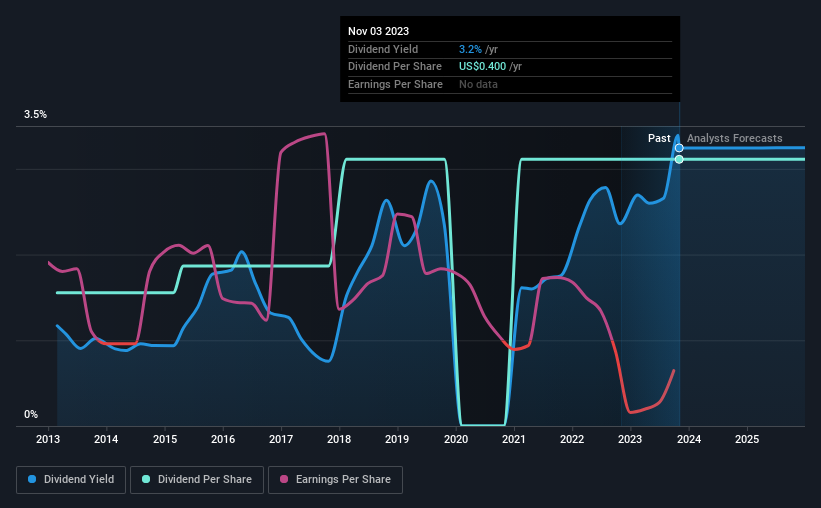Regular readers will know that we love our dividends at Simply Wall St, which is why it’s exciting to see Dana Incorporated (NYSE:DAN) is about to trade ex-dividend in the next four days. Typically, the ex-dividend date is one business day before the record date which is the date on which a company determines the shareholders eligible to receive a dividend. It is important to be aware of the ex-dividend date because any trade on the stock needs to have been settled on or before the record date. In other words, investors can purchase Dana’s shares before the 9th of November in order to be eligible for the dividend, which will be paid on the 1st of December.
The company’s upcoming dividend is US$0.10 a share, following on from the last 12 months, when the company distributed a total of US$0.40 per share to shareholders. Last year’s total dividend payments show that Dana has a trailing yield of 3.2% on the current share price of $12.33. Dividends are a major contributor to investment returns for long term holders, but only if the dividend continues to be paid. We need to see whether the dividend is covered by earnings and if it’s growing.
View our latest analysis for Dana
Dividends are usually paid out of company profits, so if a company pays out more than it earned then its dividend is usually at greater risk of being cut. Dana reported a loss last year, so it’s not great to see that it has continued paying a dividend. Considering the lack of profitability, we also need to check if the company generated enough cash flow to cover the dividend payment. If cash earnings don’t cover the dividend, the company would have to pay dividends out of cash in the bank, or by borrowing money, neither of which is long-term sustainable. Dana paid out more free cash flow than it generated – 141%, to be precise – last year, which we think is concerningly high. It’s hard to consistently pay out more cash than you generate without either borrowing or using company cash, so we’d wonder how the company justifies this payout level.
Click here to see the company’s payout ratio, plus analyst estimates of its future dividends.
Have Earnings And Dividends Been Growing?
When earnings decline, dividend companies become much harder to analyse and own safely. If business enters a downturn and the dividend is cut, the company could see its value fall precipitously. Dana was unprofitable last year and, unfortunately, the general trend suggests its earnings have been in decline over the last five years, making us wonder if the dividend is sustainable at all.
Another key way to measure a company’s dividend prospects is by measuring its historical rate of dividend growth. Since the start of our data, 10 years ago, Dana has lifted its dividend by approximately 7.2% a year on average.
Remember, you can always get a snapshot of Dana’s financial health, by checking our visualisation of its financial health, here.
The Bottom Line
Should investors buy Dana for the upcoming dividend? First, it’s not great to see the company paying a dividend despite being loss-making over the last year. Second, the dividend was not well covered by cash flow.” It’s not the most attractive proposition from a dividend perspective, and we’d probably give this one a miss for now.
With that being said, if you’re still considering Dana as an investment, you’ll find it beneficial to know what risks this stock is facing. Every company has risks, and we’ve spotted 2 warning signs for Dana you should know about.
Generally, we wouldn’t recommend just buying the first dividend stock you see. Here’s a curated list of interesting stocks that are strong dividend payers.
Have feedback on this article? Concerned about the content? Get in touch with us directly. Alternatively, email editorial-team (at) simplywallst.com.
This article by Simply Wall St is general in nature. We provide commentary based on historical data and analyst forecasts only using an unbiased methodology and our articles are not intended to be financial advice. It does not constitute a recommendation to buy or sell any stock, and does not take account of your objectives, or your financial situation. We aim to bring you long-term focused analysis driven by fundamental data. Note that our analysis may not factor in the latest price-sensitive company announcements or qualitative material. Simply Wall St has no position in any stocks mentioned.
